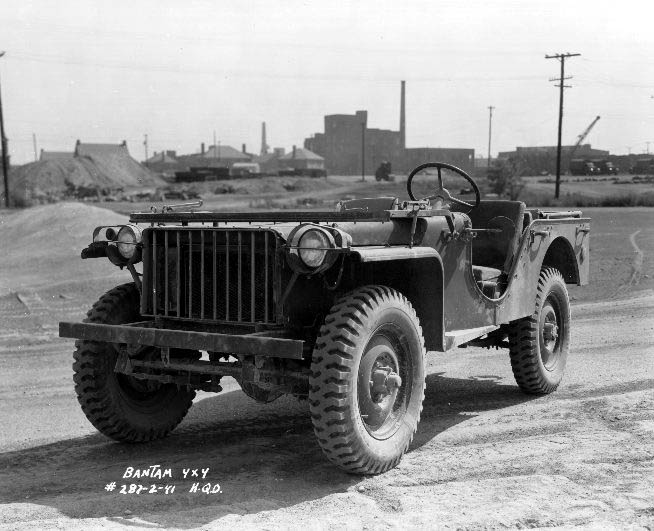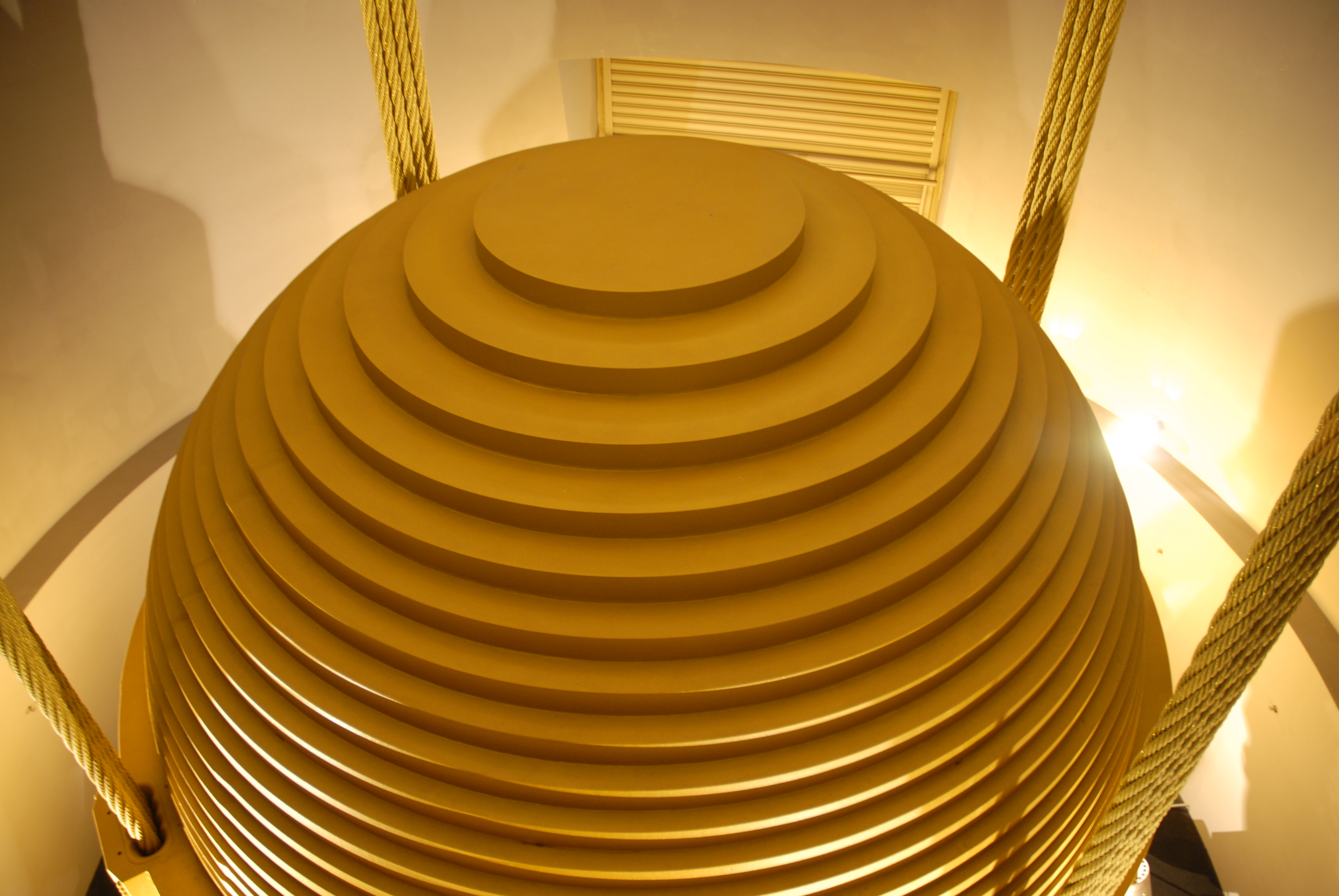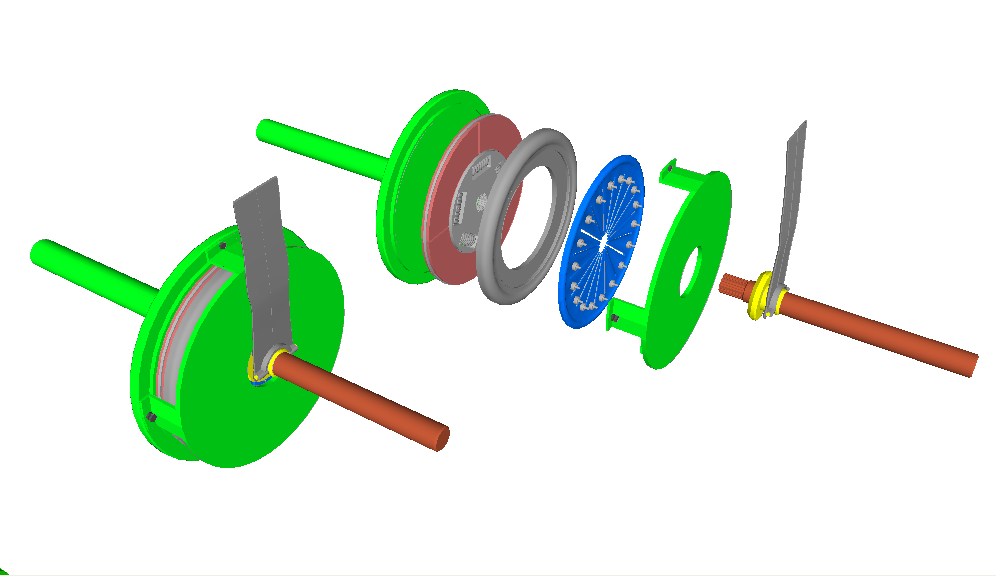|
Harmonic Damper
A harmonic damper is a device fitted to the free (accessory drive) end of the crankshaft of an internal combustion engine to counter torsional and resonance vibrations from the crankshaft. This device must be interference fit to the crankshaft in order to operate in an effective manner. An interference fit ensures the device moves in perfect step with the crankshaft. It is essential on engines with long crankshafts (such as straight-six or straight-eight engines) and V8 engines with cross plane cranks, or V6 and straight-three engines with uneven firing order. Harmonics and torsional vibrations can greatly reduce crankshaft life, or cause instantaneous failure if the crankshaft runs at or through an amplified resonance. Dampers are designed with a specific weight (mass) and diameter, which are dependent on the damping material/method used, to reduce mechanical Q factor, or damp, crankshaft resonances. A harmonic balancer (sometimes called crankshaft damper, torsional damper, ... [...More Info...] [...Related Items...] OR: [Wikipedia] [Google] [Baidu] |
Jeep 2
Jeep is an American automobile marque, now owned by multi-national corporation Stellantis. Jeep has been part of Chrysler since 1987, when Chrysler acquired the Jeep brand, along with remaining assets, from its previous owner American Motors Corporation (AMC). Jeep's current product range consists solely of sport utility vehicles – both crossovers and fully off-road worthy SUVs and models, including one pickup truck. Previously, Jeep's range included other pick-ups, as well as small vans, and a few roadsters. Some of Jeep's vehicles—such as the Grand Cherokee—reach into the luxury SUV segment, a market segment the 1963 Wagoneer is considered to have started. Jeep sold 1.4 million SUVs globally in 2016, up from 500,000 in 2008, two-thirds of which in North America, and was Fiat-Chrysler's best selling brand in the U.S. during the first half of 2017. In the U.S. alone, over 2400 dealerships hold franchise rights to sell Jeep-branded vehicles, and if Jeep were spun o ... [...More Info...] [...Related Items...] OR: [Wikipedia] [Google] [Baidu] |
Spring–mass–damper
The mass-spring-damper model consists of discrete mass nodes distributed throughout an object and interconnected via a network of springs and dampers. This model is well-suited for modelling object with complex material properties such as nonlinearity and viscoelasticity. Packages such as MATLAB may be used to run simulations of such models. As well as engineering simulation, these systems have applications in computer graphics and computer animation. Derivation (Single Mass) Deriving the equations of motion for this model is usually done by examining the sum of forces on the mass: :\Sigma F = -kx - c \dot x +F_ = m \ddot x By rearranging this equation, we can derive the standard form: :\ddot x + 2 \zeta \omega_n \dot x + \omega_n^2 x = u where \omega_n=\sqrt\frac; \quad \zeta = \frac; \quad u=\frac \omega_n is the undamped natural frequency and \zeta is the damping ratio. See also * Numerical methods * Soft body dynamics#Spring/mass models * Finite element analysis ... [...More Info...] [...Related Items...] OR: [Wikipedia] [Google] [Baidu] |
Tuned Mass Damper
A tuned mass damper (TMD), also known as a harmonic absorber or seismic damper, is a device mounted in structures to reduce mechanical vibrations, consisting of a mass mounted on one or more Damping ratio, damped springs. Its oscillation frequency is tuned to be similar to the resonant frequency of the object it is mounted to, and reduces the object's maximum amplitude while weighing much less than it. TMDs can prevent discomfort, damage, or outright structural failure. They are frequently used in power transmission, automobiles and buildings. Principle Tuned mass dampers stabilize against violent motion caused by normal mode, harmonic vibration. They use a comparatively lightweight component to reduce the vibration of a system so that its worst-case vibrations are less intense. Roughly speaking, practical systems are tuned to either move the main mode away from a troubling excitation frequency, or to add damping to a resonance that is difficult or expensive to damp direct ... [...More Info...] [...Related Items...] OR: [Wikipedia] [Google] [Baidu] |
Noise And Vibration On Maritime Vessels
Noise and vibration on maritime vessels are not the same but they have the same origin and come in many forms. The methods to handle the related problems are similar, to a certain level, where most shipboard noise problems are reduced by controlling vibration. Sources The main producers of mechanically created noise and vibration are the engines, but there are also other sources, like the air conditioning, shaft-line, cargo handling and control equipment and mooring machinery. Diesel engines When looking at diesel driven vessels, the engines induce large accelerations that travel from the foundation of the engine throughout the ship. In most compartments, this type of vibration normally manifests itself as audible noise. The problem with diesels is that, for a given size, there is a fixed amount of power generated per cylinder. To increase power it is necessary to add cylinders but, when cylinders are added, the crankshaft has to be lengthened and after a very limited number of ad ... [...More Info...] [...Related Items...] OR: [Wikipedia] [Google] [Baidu] |
Engine Balance
Engine balance refers to how the forces (resulting from combustion or rotating/reciprocating components) are balanced within an internal combustion engine or steam engine. The most commonly used terms are ''primary balance'' and ''secondary balance''. ''First-order balance'' and ''second-order balance'' are also used. Unbalanced forces within the engine can lead to vibrations. Causes of imbalance Although some components within the engine (such as the connecting rods) have complex motions, all motions can be separated into reciprocating and rotating components, which assists in the analysis of imbalances. Using the example of an inline engine (where the pistons are vertical), the main reciprocating motions are: * Pistons moving upwards/downwards * Connecting rods moving upwards/downwards * Connecting rods moving left/right as they rotate around the crankshaft, however the lateral vibrations caused by these movements are much smaller than the up–down vibrations caused by ... [...More Info...] [...Related Items...] OR: [Wikipedia] [Google] [Baidu] |
Balance Shaft
Balance shafts are used in piston engines to reduce vibration by cancelling out unbalanced dynamic forces. The counter balance shafts have eccentric weights and rotate in opposite direction to each other, which generates a net vertical force. The balance shaft was invented and patented by British engineer Frederick W. Lanchester in 1907. It is most commonly used in inline-four and V6 engines used in automobiles and motorcycles. Overview The operating principle of a balance shaft system is that two shafts carrying identical eccentric weights rotate in opposite directions at twice the engine speed. The phasing of the shafts is such that the centrifugal forces produced by the weights cancel the vertical second-order forces (at twice the engine RPM) produced by the engine. The horizontal forces produced by the balance shafts are equal and opposite, and so cancel each other. The balance shafts do not reduce the vibrations experienced by the crankshaft. Applications Two-cylinde ... [...More Info...] [...Related Items...] OR: [Wikipedia] [Google] [Baidu] |
Rolls-Royce 30 Hp
The Rolls-Royce 30 hp was one of four cars to be produced as a result of an agreement of 23 December 1904 between Charles Rolls and Henry Royce. Badged as a Rolls-Royce, the 30 hp was produced during 1905 and 1906 by Royce's company, Royce Ltd. at its factory in Cooke Street, Hulme, Manchester. It was sold exclusively by Rolls' motor dealership, C.S.Rolls & Co., at a price of GBP 890. The engine was exhibited at the Paris Salon in December 1904, along with the 10 hp, 15 hp and 20 hp models. Claude Johnson was keen that a six-cylinder model was included in the Rolls-Royce line-up as other "quality" makers, especially Napier, were adding them to their ranges. The 30 hp was discontinued when the company changed to a single model policy and launched the 40/50 (Silver Ghost). Engine The engine is made of three separately-cast two-cylinder units with monobloc heads which are common with the two-cylinder 10 hp and four-cylinder 20 hp ... [...More Info...] [...Related Items...] OR: [Wikipedia] [Google] [Baidu] |
Frederick W
Frederick may refer to: People * Frederick (given name), the name Nobility Anhalt-Harzgerode * Frederick, Prince of Anhalt-Harzgerode (1613–1670) Austria * Frederick I, Duke of Austria (Babenberg), Duke of Austria from 1195 to 1198 * Frederick II, Duke of Austria (1219–1246), last Duke of Austria from the Babenberg dynasty * Frederick the Fair (Frederick I of Austria (Habsburg), 1286–1330), Duke of Austria and King of the Romans Baden * Frederick I, Grand Duke of Baden (1826–1907), Grand Duke of Baden * Frederick II, Grand Duke of Baden (1857–1928), Grand Duke of Baden Bohemia * Frederick, Duke of Bohemia (died 1189), Duke of Olomouc and Bohemia Britain * Frederick, Prince of Wales (1707–1751), eldest son of King George II of Great Britain Brandenburg/Prussia * Frederick I, Elector of Brandenburg (1371–1440), also known as Frederick VI, Burgrave of Nuremberg * Frederick II, Elector of Brandenburg (1413–1470), Margrave of Brandenburg * Frederick Willia ... [...More Info...] [...Related Items...] OR: [Wikipedia] [Google] [Baidu] |
Henry Royce
Sir Frederick Henry Royce, 1st Baronet, (27 March 1863 – 22 April 1933) was an English engineer famous for his designs of car and aeroplane engines with a reputation for reliability and longevity. With Charles Rolls (1877–1910) and Claude Johnson (1864–1926), he founded Rolls-Royce. Rolls-Royce initially focused on large 40-50 horsepower motor cars, the Silver Ghost and its successors. Royce produced his first aero engine shortly after the outbreak of the First World War and aircraft engines became Rolls-Royce's principal product. Royce's health broke down in 1911 and he was persuaded to leave his factory in the Midlands at Derby and, taking a team of designers, move to the south of England spending winters in the south of France. He died at his home in Sussex in the spring of 1933. Early life Royce was born in Alwalton, Huntingdonshire, near Peterborough in 1863 to James and Mary Royce (née King). He was the youngest of their five children. His father ran a flou ... [...More Info...] [...Related Items...] OR: [Wikipedia] [Google] [Baidu] |
Transmission (mechanics)
Propulsion transmission is the mode of transmitting and controlling propulsion power of a machine. The term ''transmission'' properly refers to the whole drivetrain, including clutch, gearbox, prop shaft (for rear-wheel drive vehicles), differential, and final drive shafts. In the United States the term is sometimes used in casual speech to refer more specifically to the gearbox alone, and detailed usage differs. The transmission reduces the higher engine speed to the slower wheel speed, increasing torque in the process. Transmissions are also used on pedal bicycles, fixed machines, and where different rotational speeds and torques are adapted. Often, a transmission has multiple gear ratios (or simply "gears") with the ability to switch between them as the speed varies. This switching may be done manually (by the operator) or automatically (by a control unit). Directional (forward and reverse) control may also be provided. Single-ratio transmissions also exist, which simply ... [...More Info...] [...Related Items...] OR: [Wikipedia] [Google] [Baidu] |
Clutch
A clutch is a mechanical device that engages and disengages power transmission, especially from a drive shaft to a driven shaft. In the simplest application, clutches connect and disconnect two rotating shafts (drive shafts or line shafts). In these devices, one shaft is typically attached to an engine or other power unit (the driving member), while the other shaft (the driven member) provides output power for work. Typically the motions involved are rotary, but linear clutches also exist. In a motor vehicle, the clutch acts as a mechanical linkage between the engine and transmission, and briefly disconnects, or separates the engine from the transmission system. This disconnects the drive wheels whenever the clutch pedal is depressed, allowing the driver to smoothly change gears. In a torque-controlled drill, for instance, one shaft is driven by a motor, and the other drives a drill chuck. The clutch connects the two shafts so they may be locked together and spin at th ... [...More Info...] [...Related Items...] OR: [Wikipedia] [Google] [Baidu] |




_031.jpg)

